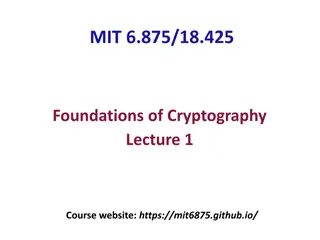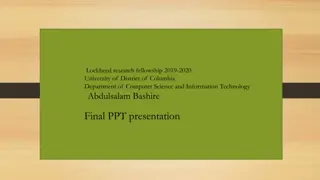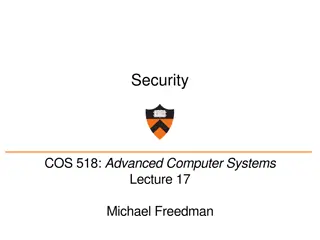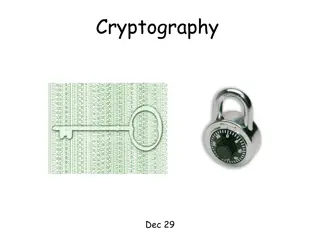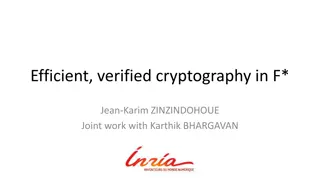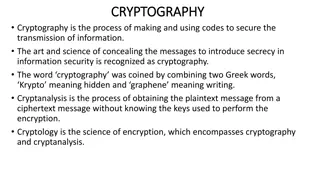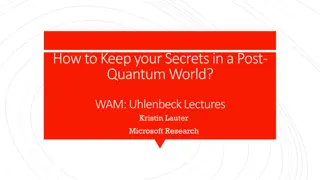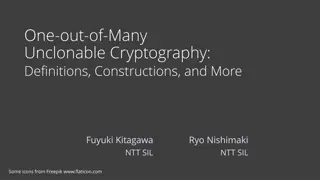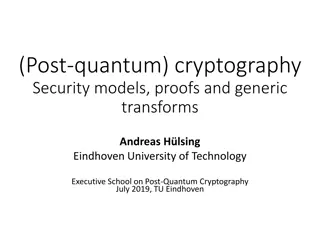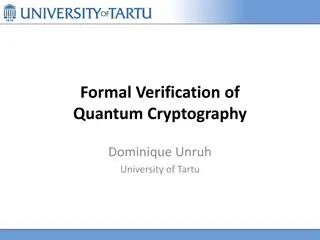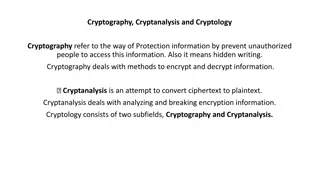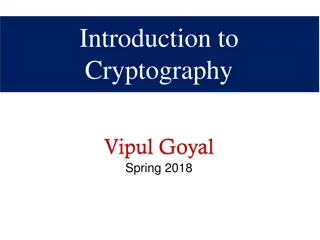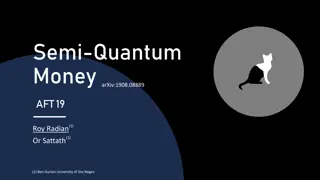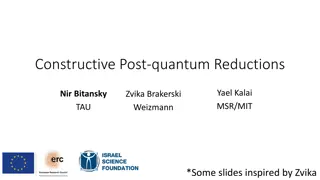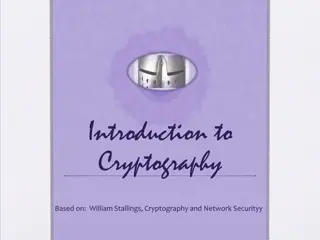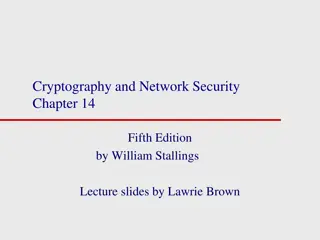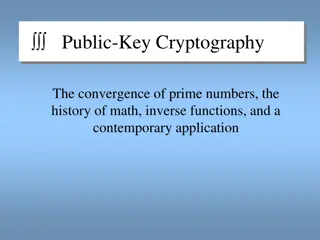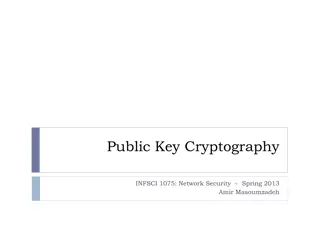Practical Aspects of Modern Cryptography: November 2016
Exploring session-based protocols, SSL/TLS, certificates, and public key infrastructure, this presentation delves into the motivation behind secure online interactions, discussing the importance of verifying identities, ensuring data confidentiality, maintaining message integrity, and authenticating message origins within security protocols like Kerberos. The history and evolution of Kerberos, a key symmetric authentication protocol, are also highlighted.
Uploaded on Sep 29, 2024 | 0 Views
Download Presentation

Please find below an Image/Link to download the presentation.
The content on the website is provided AS IS for your information and personal use only. It may not be sold, licensed, or shared on other websites without obtaining consent from the author. Download presentation by click this link. If you encounter any issues during the download, it is possible that the publisher has removed the file from their server.
E N D
Presentation Transcript
Josh Benaloh Tolga Acar Fall 2016 November 1, 2016 Practical Aspects of Modern Cryptography 1
Agenda Protocols: Session-based protocols Introduction Kerberos SSL/TLS Certificates and Public Key Infrastructure (PKI) Certificates Public Key Infrastructure Certificate Lifecycle Management Revocation November 1, 2016 Practical Aspects of Modern Cryptography 2
Motivation November 1, 2016 Practical Aspects of Modern Cryptography 3
Motivation November 1, 2016 Practical Aspects of Modern Cryptography 4
Motivation November 1, 2016 Practical Aspects of Modern Cryptography 5
Motivation How do I know the web site I m talking to is really who I think it is? Is it safe to view to give sensitive information over the Web? What keeps my CC#, SSN, financial information or medical records out of the hands of the bad guys? How do I know that the information I m looking at hasn t been maliciously modified? Has someone tampered with it? November 1, 2016 Practical Aspects of Modern Cryptography 6
Security Protocol Properties Confidentiality Keeping message content secret, even if the information passes over a public channel Integrity Keeping messages tamper-free from origin to destination Authentication Determining the origin of messages (author and/or sender) November 1, 2016 Practical Aspects of Modern Cryptography 7
Agenda Protocols: Session-based protocols Introduction Kerberos SSL/TLS Certificates and Public Key Infrastructure (PKI) Certificates Public Key Infrastructure Certificate Lifecycle Management Revocation November 1, 2016 Practical Aspects of Modern Cryptography 8
Kerberos History Based on symmetric Needham-Schroeder (1978) Designed as part of MIT s Project Athena in the 1980 s Kerberos v4 published in 1987 Migration to the IETF RFC 1510 (Kerberos v5, 1993) Used in a number of products Example: Windows domains (since Windows 2000) Many web-based authentication protocols (e.g. Windows Live ID) are Kerberos inspired using HTTP and client-side cookies OAuthv2 is also Kerberos inspired November 1, 2016 Practical Aspects of Modern Cryptography 9
Kerberos Designed for a single Administration Domain of machines & users No public key crypto PKINIT is added as a pre-auth mechanism later on Provides authentication & encryption services Kerberized servers provide authorization on top of the authenticated identities November 1, 2016 Practical Aspects of Modern Cryptography 10
The Kerberos Model Clients Servers The Key Distribution Center (KDC) Centralized trust model KDC is trusted by all clients & servers KDC shares a secret, symmetric key with each client and server A realm is single trust domain consisting of one or more clients, servers, KDCs November 1, 2016 Practical Aspects of Modern Cryptography 11
Picture of a Kerberos Realm Key Distribution Center (KDC) Ticket Granting Server (TGS) Server Client November 1, 2016 Practical Aspects of Modern Cryptography 12
Limitations Password guessing attacks Trusted path requirement for password entry Loose time synchronization (clock skew) Denial of service attacks Trust in the key distribution center November 1, 2016 Practical Aspects of Modern Cryptography 13
Joining a Kerberos Realm One-time setup Each client, server that wishes to participate in the realm exchanges a secret key with the KDC If the KDC is compromised, the entire system is cracked Because the KDC knows everyone s individual secret key, the KDC can issue credentials to each realm identity November 1, 2016 Practical Aspects of Modern Cryptography 14
Kerberos Credentials Two types of credentials in Kerberos Tickets Authenticators Tickets are credentials issued to a client for communication with a specific server Authenticators are additional credentials that prove a client knows a key at a point in time Basic idea: encrypt a nonce November 1, 2016 Practical Aspects of Modern Cryptography 15
The Basic Kerberos Protocol Assume client C wishes to authenticate to and communicate with server S 1. Phase 1: C gets a Ticket-Granting Ticket (TGT) from the KDC 2. Phase 2: C uses the TGT to get a Ticket for S 3. Phase 3: C communicates with S November 1, 2016 Practical Aspects of Modern Cryptography 16
Protocol Definitions C = client, S = server TGS = ticket-granting service Kx= x s secret key Kx,y = session key for x and y {m}Kx= m encrypted in x s secret key Tx,y= x s ticket to use y Ax,y = authenticator from x to y Nx = a nonce generated by x November 1, 2016 Practical Aspects of Modern Cryptography 17
The Basic Kerberos Protocol (1) Phase 1: C gets a Ticket Granting Ticket 1. C sends a request to the KDC for a ticket-granting ticket (TGT) A TGT is a ticket used to talk to the special ticket- granting service A TGT is relatively long-lived (~8-24 hours typically) C KDC: C, TGS, NC Sent in the clear! November 1, 2016 Practical Aspects of Modern Cryptography 18
The Basic Kerberos Protocol (2) Phase 1: C gets a Ticket-Granting Ticket 2. KDC responds with two items The ticket-granting ticket A ticket for C to talk to TGS A copy of the session key to use to talk to TGS, encrypted in C s shared key KDC C: TC,TGS, {KC,TGS}KC where TC,TGS = TGS, {C, C-addr, lifetime, KC,TGS}KTGS Only the TGS can decrypt the ticket C can unlock the second part to retrieve KC,TGS November 1, 2016 Practical Aspects of Modern Cryptography 19
Picture of a Kerberos Realm Key Distribution Center (KDC) KDC C: TC,TGS, {KC,TGS}KC C KDC: C, TGS, NC TC,TGS = TGS, {C, C-addr, lifetime, KC,TGS}KTGS Client November 1, 2016 Practical Aspects of Modern Cryptography 20
The Basic Kerberos Protocol (3) Phase 2: C gets a Ticket for S 3. C requests a ticket to communicate with S from the ticket-granting service (TGS) C sends TGT to S along with an authenticator requesting a ticket from C to S C TGS: {AC,S}KC,TGS , TC,TGS where Ac,s = {c, timestamp, opt. subkey} First part proves to TGS that C knows the session key Second part is the TGT C received from the KDC November 1, 2016 Practical Aspects of Modern Cryptography 21
The Basic Kerberos Protocol (4) Phase 2: C gets a Ticket for S 4. TGS returns a ticket for C to talk to S (Just like step 2 above...) TGS C: TC,S , {KC,S}KC,TGS Where TC,S = S, {C, C-addr, lifetime, KC,S}KS Only S can decrypt the ticket TC,S C can unlock the second part to retrieve KC,S November 1, 2016 Practical Aspects of Modern Cryptography 22
Picture of a Kerberos Realm Ticket Granting Server (TGS) C TGS: {AC,S}KC,TGS , TC,TGS Ac,s = {c, timestamp, opt. subkey} TGS C: TC,S , {KC,S}KC,TGS Client November 1, 2016 Practical Aspects of Modern Cryptography 23
The Basic Kerberos Protocol (5) Phase 3: C communicates with S 5. C sends the ticket to S along with an authenticator to establish a shared secret C S: {AC,S}KC,S , TC,S where Ac,s = {c, timestamp, opt. subkey} TC,S = S, {C, C-addr, lifetime, KC,S}KS S decrypts the ticket TC,S to get the shared secret KC,S needed to communicate securely with C November 1, 2016 Practical Aspects of Modern Cryptography 24
The Basic Kerberos Protocol (6) Phase 3: C communicates with S 6. S decrypts the ticket to obtain the KC,S and replies to C with proof of possession of the shared secret (optional step) S C: {timestamp, opt. subkey}Kc,s Notice that S had to decrypt the authenticator, extract the timestamp & opt. subkey, and re- encrypt those two components with Kc,s November 1, 2016 Practical Aspects of Modern Cryptography 25
Picture of a Kerberos Realm C S: {AC,S} Kc,s, TC,S where Ac,s = {c, timestamp, opt. subkey} Server Client S C: {timestamp, opt. subkey}Kc,s November 1, 2016 Practical Aspects of Modern Cryptography 26
Picture of a Kerberos Realm Key Distribution Center (KDC) Ticket Granting Server (TGS) Ticket Request TGT Request TGT Ticket Ticket + service request Do some stuff Server Client November 1, 2016 Practical Aspects of Modern Cryptography 27
Thoughts on Kerberos... Only the KDC needs to know the user s password (used to generate the shared secret) You can have multiple KDCs for redundancy, but they all need to have a copy of the username/password database Q: Is it possible not to record the password? Only the TGS needs to know the secret keys for the servers You can split KDC from TGS, but it is common for those two services to reside on the same physical machine November 1, 2016 Practical Aspects of Modern Cryptography 28
Thoughts on Kerberos...(2) Time is very important in Kerberos All participants in the realm need accurate clocks Timestamps are used in authenticators to detect replay; if a host can be fooled about the current time, old authenticators could be replayed Tickets tend to have lifetimes on the order of hours, and replays are possible during the lifetime of the ticket Bearer Credentials: Capture it, you are the owner of the ticket (sometimes called token in OAuthv2) November 1, 2016 Practical Aspects of Modern Cryptography 29
Thoughts on Kerberos...(3) Password-guessing attacks are possible Capture enough encrypted tickets and you can brute-force decrypt them to discover shared keys It s possible to screw up the implementation In fact, Kerberos v4 had a colossal security breach due to bad implementations November 1, 2016 Practical Aspects of Modern Cryptography 30
RNGs in Kerberos v4 Session keys were generated from a PRNG seeded with the XOR of the following: Time-of-day in seconds since 1/1/1970 Process ID of the Kerberos server process Cumulative count of session keys generated Fractional part of time-of-day seconds Hostid of the machine running the server November 1, 2016 Practical Aspects of Modern Cryptography 31
RNGs in Kerberos v4 (continued) The seed is a 32-bit value, so while the session key is used for DES (64 bits long, normally 56 bits of entropy), it has only 32 bits of entropy What s worse, the five values have predictable portions Time is completely predictable ProcessID is mostly predictable Even hostID has 12 predictable bits (of 32 total) November 1, 2016 Practical Aspects of Modern Cryptography 32
RNGs in Kerberos v4 (continued) Of the 32 seed bits, only 20 bits really change with any frequency, so Kerberos v4 keys (in the MIT implementation) only have 20 bits of randomness They could be brute-force discovered in seconds The hole was in the MIT Kerberos sources for seven years! November 1, 2016 Practical Aspects of Modern Cryptography 33
Agenda Protocols: Session-based protocols Introduction Kerberos SSL/TLS Public Key Infrastructure (PKI) November 1, 2016 Practical Aspects of Modern Cryptography 34
App-Level Security: TLS November 1, 2016 Practical Aspects of Modern Cryptography 35
TLS for which content? November 1, 2016 Practical Aspects of Modern Cryptography 36
TLS: Certificates more later November 1, 2016 Practical Aspects of Modern Cryptography 37
SSL/PCT/TLS History 1994: Secure Sockets Layer (SSL) V2.0 1995: Private Communication Technology (PCT) V1.0 1996: Secure Sockets Layer (SSL) V3.0 1997: Private Communication Technology (PCT) V4.0 1999: Transport Layer Security (TLS) V1.0 2006: TLS V1.1 (RFC 4346) 2008: TLS V1.2 (RFC 5246) 2016: TLS V1.3 (I-D Version 13), ETA: May 2017? November 1, 2016 Practical Aspects of Modern Cryptography 38
Typical Scenario You (client) Merchant (server) Let s talk securely Here is my RSA public key Here is a symmetric key, encrypted with your public key, that we can use to talk November 1, 2016 Practical Aspects of Modern Cryptography 39
TLS (SSL) You (client) Merchant (server) Let s talk securely Here are the protocols and ciphers I understand Here is my RSA public key Here is a symmetric key, encrypted with your public key, that we can use to talk November 1, 2016 Practical Aspects of Modern Cryptography 40
TLS (SSL) You (client) Merchant (server) Let s talk securely I choose this protocol and ciphers. Here is my public key and some other stuff. Here is a symmetric key, encrypted with your public key, that we can use to talk November 1, 2016 Practical Aspects of Modern Cryptography 41
TLS (SSL) You (client) Merchant (server) Let s talk securely. Here are the protocols and ciphers I understand. I choose this protocol and ciphers. Here is my public key and some other stuff. Here is a symmetric key, encrypted with your public key, that we can use to talk November 1, 2016 Practical Aspects of Modern Cryptography 42
SSL/TLS All subsequent secure messages are protected using symmetric keys Key derivation from the agreed-upon secret HMAC and Encryption with two separate keys Authenticated encryption with a key November 1, 2016 Practical Aspects of Modern Cryptography 43
The five phases of SSL/TLS 1. Negotiate the ciphersuite to be used 2. Establish the shared session key 3. Client authenticates the server ( server auth ) Optional, but almost always done Typical for consumer-oriented Internet 4. Server authenticates the client ( client auth ) Optional, and almost never done Typical for data center applications 5. Authenticate previously exchanged data November 1, 2016 Practical Aspects of Modern Cryptography 44
Phase 1: Ciphersuite Negotiation Client hello (client server) Hi! I speak these ciphersuites, and here s a 46-byte random number (nonce) I just picked struct { ProtocolVersion client_version; opaque random[46]; } PreMasterSecret; Server hello (client server) Hello. We re going to use this particular ciphersuite, and here s a 46-byte nonce I just picked. Other info can be passed along (we ll see why a little later...) November 1, 2016 Practical Aspects of Modern Cryptography 45
TLS V1.0 ciphersuites TLS_NULL_WITH_NULL_NULL TLS_RSA_WITH_NULL_MD5 TLS_RSA_WITH_NULL_SHA TLS_RSA_EXPORT_WITH_RC4_40_MD5 TLS_RSA_WITH_RC4_128_MD5 TLS_RSA_WITH_RC4_128_SHA TLS_RSA_EXPORT_WITH_RC2_CBC_40_M D5 TLS_RSA_WITH_IDEA_CBC_SHA TLS_RSA_EXPORT_WITH_DES40_CBC_SH A TLS_RSA_WITH_DES_CBC_SHA TLS_RSA_WITH_3DES_EDE_CBC_SHA TLS_DH_DSS_EXPORT_WITH_DES40_CBC _SHA TLS_DH_DSS_WITH_DES_CBC_SHA TLS_DH_DSS_WITH_3DES_EDE_CBC_SHA TLS_DH_RSA_EXPORT_WITH_DES40_CBC_S HA TLS_DH_RSA_WITH_DES_CBC_SHA TLS_DH_RSA_WITH_3DES_EDE_CBC_SHA TLS_DHE_DSS_EXPORT_WITH_DES40_CBC_ SHA TLS_DHE_DSS_WITH_DES_CBC_SHA TLS_DHE_DSS_WITH_3DES_EDE_CBC_SHA TLS_DHE_RSA_EXPORT_WITH_DES40_CBC_ SHA TLS_DHE_RSA_WITH_DES_CBC_SHA TLS_DHE_RSA_WITH_3DES_EDE_CBC_SHA TLS_DH_anon_EXPORT_WITH_RC4_40_MD5 TLS_DH_anon_WITH_RC4_128_MD5 TLS_DH_anon_EXPORT_WITH_DES40_CBC_ SHA TLS_DH_anon_WITH_DES_CBC_SHA TLS_DH_anon_WITH_3DES_EDE_CBC_SHA November 1, 2016 Practical Aspects of Modern Cryptography 46
TLS V1.2 Ciphersuites (some, RFC5246) TLS_RSA_WITH_NULL_MD5 = { 0x00,0x01 }; TLS_RSA_WITH_NULL_SHA = { 0x00,0x02 }; TLS_RSA_WITH_NULL_SHA256 = { 0x00,0x3B }; TLS_RSA_WITH_RC4_128_MD5 = { 0x00,0x04 }; TLS_RSA_WITH_RC4_128_SHA = { 0x00,0x05 }; TLS_RSA_WITH_3DES_EDE_CBC_SHA = { 0x00,0x0A }; TLS_RSA_WITH_AES_128_CBC_SHA = { 0x00,0x2F }; TLS_RSA_WITH_AES_256_CBC_SHA = { 0x00,0x35 }; TLS_RSA_WITH_AES_128_CBC_SHA256 = { 0x00,0x3C }; TLS_RSA_WITH_AES_256_CBC_SHA256 = { 0x00,0x3D }; TLS_DH_DSS_WITH_3DES_EDE_CBC_SHA = { 0x00,0x0D }; TLS_DH_RSA_WITH_3DES_EDE_CBC_SHA = { 0x00,0x10 }; TLS_DHE_DSS_WITH_3DES_EDE_CBC_SHA = { 0x00,0x13 }; TLS_DHE_RSA_WITH_3DES_EDE_CBC_SHA = { 0x00,0x16 }; TLS_DH_DSS_WITH_AES_128_CBC_SHA = { 0x00,0x30 }; TLS_DH_RSA_WITH_AES_128_CBC_SHA = { 0x00,0x31 }; TLS_DHE_DSS_WITH_AES_128_CBC_SHA = { 0x00,0x32 }; TLS_DHE_RSA_WITH_AES_128_CBC_SHA = { 0x00,0x33 }; TLS_DH_DSS_WITH_AES_256_CBC_SHA = { 0x00,0x36 }; TLS_DH_RSA_WITH_AES_256_CBC_SHA = { 0x00,0x37 }; TLS_DHE_DSS_WITH_AES_256_CBC_SHA = { 0x00,0x38 }; TLS_DHE_RSA_WITH_AES_256_CBC_SHA = { 0x00,0x39 }; TLS_DH_DSS_WITH_AES_128_CBC_SHA256 = { 0x00,0x3E }; TLS_DH_RSA_WITH_AES_128_CBC_SHA256 = { 0x00,0x3F }; TLS_DHE_DSS_WITH_AES_128_CBC_SHA256 = { 0x00,0x40 }; TLS_DHE_RSA_WITH_AES_128_CBC_SHA256 = { 0x00,0x67 }; TLS_DH_DSS_WITH_AES_256_CBC_SHA256 = { 0x00,0x68 }; TLS_DH_RSA_WITH_AES_256_CBC_SHA256 = { 0x00,0x69 }; TLS_DHE_DSS_WITH_AES_256_CBC_SHA256 = { 0x00,0x6A }; TLS_DHE_RSA_WITH_AES_256_CBC_SHA256 = { 0x00,0x6B }; November 1, 2016 Practical Aspects of Modern Cryptography 47
ECC-based ciphersuites (RFC 4492) TLS_ECDH_ECDSA_WITH_NULL_SHA TLS_ECDH_ECDSA_WITH_RC4_128_SHA TLS_ECDH_ECDSA_WITH_3DES_EDE_CBC_SHA TLS_ECDH_ECDSA_WITH_AES_128_CBC_SHA TLS_ECDH_ECDSA_WITH_AES_256_CBC_SHA TLS_ECDH_RSA_WITH_NULL_SHA TLS_ECDH_RSA_WITH_RC4_128_SHA TLS_ECDH_RSA_WITH_3DES_EDE_CBC_SHA TLS_ECDH_RSA_WITH_AES_128_CBC_SHA TLS_ECDH_RSA_WITH_AES_256_CBC_SHA TLS_ECDHE_RSA_WITH_NULL_SHA TLS_ECDHE_RSA_WITH_RC4_128_SHA TLS_ECDHE_RSA_WITH_3DES_EDE_CBC_SHA TLS_ECDHE_RSA_WITH_AES_128_CBC_SHA TLS_ECDHE_RSA_WITH_AES_256_CBC_SHA TLS_ECDHE_ECDSA_WITH_NULL_SHA TLS_ECDHE_ECDSA_WITH_RC4_128_SHA TLS_ECDHE_ECDSA_WITH_3DES_EDE_CBC_SHA TLS_ECDHE_ECDSA_WITH_AES_128_CBC_SHA TLS_ECDHE_ECDSA_WITH_AES_256_CBC_SHA TLS_ECDH_anon_WITH_NULL_SHA TLS_ECDH_anon_WITH_RC4_128_SHA TLS_ECDH_anon_WITH_3DES_EDE_CBC_SHA TLS_ECDH_anon_WITH_AES_128_CBC_SHA TLS_ECDH_anon_WITH_AES_256_CBC_SHA November 1, 2016 Practical Aspects of Modern Cryptography 48
Phase 2: Establish the shared session key Client key exchange Client chooses a 48-byte pre-master secret Client encrypts the pre-master secret with the server s RSA public key Client server encrypted pre-master secret Client and server both compute PRF (pre-master secret, master secret , client nonce + server nonce) PRF: HMAC-based pseudo-random function First 48 bytes output from PRF form master secret November 1, 2016 Practical Aspects of Modern Cryptography 49
TLSs PRF (V1.0 & V1.1) PRF(secret, label, seed) = P_MD5(S1, label + seed) XOR P_SHA-1(S2, label + seed); where S1, S2 are the two halves of the secret P_hash(secret, seed) = HMAC_hash(secret, A(1) + seed) + HMAC_hash(secret, A(2) + seed) + HMAC_hash(secret, A(3) + seed) + ... A(0) = seed A(i) = HMAC_hash(secret, A(i-1)) November 1, 2016 Practical Aspects of Modern Cryptography 50





